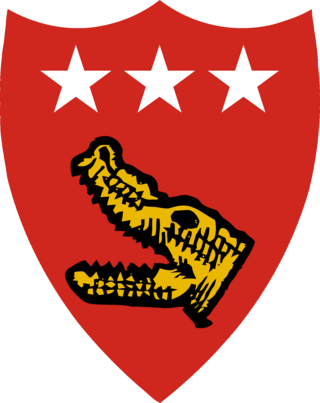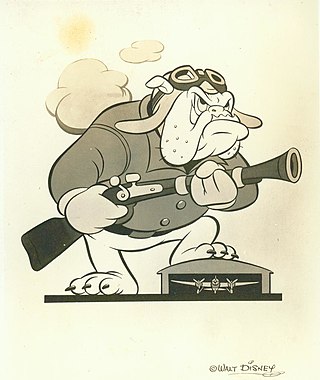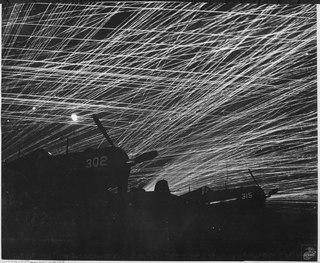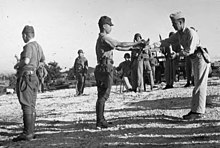
The V Amphibious Corps (VAC) was a formation of the United States Marine Corps which was composed of the 3rd, 4th and 5th Marine Divisions in World War II. The three divisions were the amphibious landing force for the United States Fifth Fleet with two goals, removal of Japanese forces from islands so U.S. Seabees could build advance bases to project US power. In doing this VAC was notably involved in the battles for Tarawa, Saipan, and Iwo Jima. V Amphibious Corps was commanded by General Holland 'Howlin Mad' Smith followed by General Harry Schmidt.

Marine Defense Battalions were United States Marine Corps battalions charged with coastal and air defense of advanced naval bases during World War II. They maintained large anti-ship guns, anti-aircraft guns, searchlights, and small arms to repel landing forces.

20th Marine Regiment was a Composite Engineer Regiment of the United States Marine Corps that fought during World War II.

The 18th Marine Regiment was a composite engineer regiment of the United States Marine Corps subordinate to the 2nd Marine Division. It was disbanded during the war, with the 1st and 2nd battalions remaining in the Division.

3rd Littoral Anti-Air Battalion is a United States Marine Corps aviation command and control and air defense unit that is optimized for operations in the first island chain. The battalion is based at Marine Corps Base Hawaii and falls under the command of the 3rd Marine Littoral Regiment and the 3rd Marine Division.
The 2nd 90mm Antiaircraft Artillery Gun Battalion was a United States Marine Corps antiaircraft unit that was active during the 1940s & 1950s. Originally formed during World War II as the 9th Defense Battalion, the battalion took part in combat operations on Guadalcanal, Rendova, Munda Point, and Guam. Like most other Marine defense battalions, the unit was re-designated in September 1944, becoming the 9th Antiaircraft Artillery Battalion. Returning to the United States in 1946, the battalion was again re-designated, this time as the 1st Antiaircraft Artillery Battalion. The battalion received its final designation as the 2nd 90mm Antiaircraft Artillery Battalion on August 21, 1950. It was later decommissioned on September 15, 1956 at Marine Corps Base 29 Palms, California.
The 2d Antiaircraft Artillery Battalion was a United States Marine Corps antiaircraft unit that served during World War II. Formed in 1940 as the 2d Defense Battalion, its original mission was to provide air and coastal defense for advanced naval bases. During the war the battalion defended Hawaii, Tutuila in American Samoa and Guam and took part in combat operations at Tarawa Atoll and Okinawa. The battalion returned to the United States after the war and was decommissioned at Marine Corps Base Camp Pendleton, California on 28 November 1945.

The 8th Antiaircraft Artillery Battalion was a United States Marine Corps antiaircraft unit that served during World War II. Formed in 1942 as the 8th Defense Battalion, its original mission was the air and coastal defense of advanced naval bases. During the war the battalion defended Tutuila in American Samoa, Wallis Island and Apamama and took part in combat operations at Okinawa. The battalion returned to the United States after the war and was decommissioned on 28 November 1945.
The 16th Antiaircraft Artillery Battalion was a United States Marine Corps antiaircraft unit that served during World War II. Formed in 1942 as the 16th Defense Battalion, its original mission was the air and coastal defense of advanced naval bases. During the war the battalion defended Johnston Island, Hawaii and Tinian and took part in combat operations at Okinawa. The battalion returned to the United States after the war and was decommissioned on 30 November 1945 at Marine Corps Base Camp Pendleton, California.

The 12th Antiaircraft Artillery Battalion was a United States Marine Corps antiaircraft unit that served during World War II. Formed in 1942 as the 12th Defense Battalion, its original mission was providing air and coastal defense for advanced naval bases. During the war the battalion defended the Russell Islands and took part in combat operations at Woodlark Island, Cape Gloucester, and Peleliu. The battalion remained on Peleliu for the duration of the war and was finally decommissioned on Guam on 22 September 1945.
The 4th Antiaircraft Artillery Battalion was a United States Marine Corps antiaircraft unit that served during World War II. Formed in 1940 as the 4th Defense Battalion, its original mission was providing air and coastal defense of advanced naval bases. It was one of first five defense battalions deployed in support of the color-coded war plans that called for the defense of Hawaii and other outlying United States possessions in the Pacific Ocean. These five battalions were nicknamed the "Rainbow Five." During the war the battalion took part in combat operations during the attack on Pearl Harbor and at Vella Lavella. The battalion was decommissioned on 9 June 1945 before the end of the war.
The 5th Antiaircraft Artillery Battalion was a United States Marine Corps antiaircraft unit that served during World War II. Formed in 1940 as the 5th Defense Battalion, its original mission was providing air and coastal defense for advanced naval bases. Prior to World War II the battalion deployed to Iceland as part of the 1st Provisional Marine Brigade in order to defend the neutral country from possible German attack. Following the Iceland deployment and a period of rest and refitting at home the battalion again deployed overseas to provide air defense for Funafuti in the Ellice Islands from September 1942 through February 1944. Also in 1942, two batteries from the 5th were dispatched to support operations on Tulagi during the Guadalcanal Campaign. These two batteries were later reorganized as part of the newly formed 14th Defense Battalion. The 5th Defense Battalion was re-designated as the 5th Antiaircraft Artillery Battalion in April 1944 and took part in the Battle of Okinawa in 1945. After the war the battalion returned to the United States where it was decommissioned in November 1945. Because the 14th Defense Battalion was formed from batteries belonging to the 5th Defense Battalion the two units retained close ties throughout the war. The 14th was nicknamed "Five:Fourteenth" and after the war the battalions formed a single alumni association.
The 10th Antiaircraft Artillery Battalion was a United States Marine Corps antiaircraft unit that served during World War II. Formed in 1942 as the 10th Defense Battalion, its original mission was to provide air and coastal defense for advanced naval bases. During the war the battalion took part in combat operations in the Russell Islands and at the Eniwetok. The battalion's tank platoon also saw extensive action on New Georgia and Arundel Island. The battalion was decommissioned before the end of the war on 25 November 1944.
The 11th Antiaircraft Artillery Battalion was a United States Marine Corps antiaircraft unit that served during World War II. Formed in 1942 as the 11th Defense Battalion, its original mission was to provide air and coastal defense for advanced naval bases. During the war the battalion defended took part in combat operations in the Solomon Islands. The battalion's tank platoon also saw extensive action on New Georgia and Arundel Island. The battalion was decommissioned before the end of the war on December 15, 1944.

The 17th Antiaircraft Artillery Battalion was an antiaircraft unit in the United States Marine Corps that served during World War II. The battalion was originally formed in 1942 as the 2d Airdrome Battalion and has the distinction of being the last defense battalion formed in the Marine Corps during the war. Its original mission was to provide air and coastal defense for advanced naval bases. During the war the battalion spent significant time defending Nukufetau and took part in combat operations at Tarawa and Tinian. The battalion was decommissioned on December 6, 1945.
The 15th Antiaircraft Artillery Battalion was an antiaircraft unit in the United States Marine Corps that served during World War II. The battalion was originally formed in 1942 as the 1st Airdrome Battalion. Its original mission was to provide air defense for advanced naval bases. During the war the battalion took part in combat operations in the Marshall. The battalion was one of the first defense battalions to be decommissioned on November 25, 1944.
The 14th Antiaircraft Artillery Battalion was an antiaircraft unit in the United States Marine Corps that served during World War II. The battalion was originally formed in 1943 as the 14th Defense Battalion. Its mission was to provide air and coastal defense for advanced naval bases. During the war the battalion took part in combat operations in the Solomon Islands and on Guam. The battalion was decommissioned on June 30, 1945. Since then no other unit has carried the lineage and honors of the 14th Antiaircraft Artillery Battalion.

The 3d Antiaircraft Artillery Battalion (Composite) (3d AAA Bn (Composite)) was an antiaircraft unit in the United States Marine Corps that served during World War II. The battalion was originally formed in 1943 as the 52d Defense Battalion, one of the first African American units in the Marine Corps. Its original mission was to provide air and coastal defense for advanced naval bases. During the war the battalion served as garrison forces on Roi-Namur, Majuro, and Guam. The battalion returned to Marine Corps Base Camp Lejeune, North Carolina after the war. It was the last of the defense battalions before it was re-designated as the 3d Antiaircraft Artillery Battalion in May 1946. The battalion was decommissioned on May 15, 1947.

The 51st Defense Battalion was an antiaircraft and coastal defense unit in the United States Marine Corps that served during World War II. The battalion was originally formed in August 1942 and was the first African American unit in the Marine Corps. Its original mission was to provide air and coastal defense for advanced naval bases. During the war the battalion served in the Ellice and Marshall Islands, in the Pacific Theater. The 51st returned to Marine Corps Base Camp Lejeune, North Carolina after the war and was decommissioned on January 31, 1946. To date, no other Marine Corps battalion has carried the lineage and honors of the 51st Defense Battalion.

The 1st Provisional Antiaircraft Artillery Group was a provisional unit that served as the headquarters for all United States Marine Corps antiaircraft battalions that participated in the Battle of Okinawa. The group was formed on Kauai, Territory of Hawaii in November 1944 under the command of the III Marine Amphibious Corps. For the Battle of Okinawa, the group was under the command of the 53d Antiaircraft Artillery Brigade of the Tenth United States Army and was responsible for air defense of the area surrounding Yontan & Kadena Airfields. Following the end of the war, the group returned to the United States and was decommissioned on December 5, 1945. To date, no other Marine Corps unit has carried the group's lineage and honors













